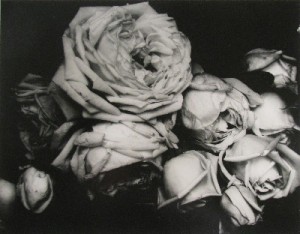Culture Vulture at the Williams College Museum of Art
Almost every visit to the WCMA has piqued my interest so strongly that I’ve often gone straight to the internet or library to read more about what I’ve seen.

Edward Steichen’s 1914 photograph “Heavy Roses”
The Williams College Museum of Art, set back from Williamstown’s main drag and almost indistinguishable from other college buildings, has long been overshadowed by the world-famous Sterling and Francine Clark Art Institute. This summer is no exception: crowds are flocking to its “Dove/O’Keeffe: Circles of Influence” exhibit that looks at Dove’s influence on O’Keeffe’s work and O’Keeffe’s impact on Dove’s.
While I’m a long-time fan of the Clark, I have rarely been startled by an exhibit there while almost every visit to the WCMA has piqued my interest so strongly that I’ve often gone straight to the internet or library to read more about what I’ve seen. This summer’s WCMA’s offerings are no exception. It’s a “teaching museum” not only for its students but for the wider community. Frugal travelers might also note that admission is free.
There are four exhibits currently running at this hugely under-visited museum: “Ralph LIeberman: Photographs”; Edward Steichen: Episodes from a Life in Photography” and “In High Fashion, the Conde Nast Years 1923-1937”; and “Prendergast in Italy.”
“Prendergast in Italy” (July 18 through September 20, 2009) is the first exhibition devoted exclusively to the watercolors, monotypes, and oil paintings by American Post-Impressionist Maurice Prendergast (1858-1924). Organized in partnership with the Terra Foundation for American Art, it was years in the planning and includes not only views of Venice, Rome. Sienna, and Capri, but some of the artist’s letters and sketchbooks as well as photographs and guidebooks. It’s a beautifully mounted and curated show designed to present Prendergast as a master on the cutting edge of American modernism.
 He quit school at 15 to apprentice at a lithography firm where he eventually designed ads for local flour mills and pork packers and purchased his first camera a year later. He read about art, artists and the developing field of photography in his local public library and was instrumental in the founding of the Milwaukee Arts Students League. By the age of 20, he had shown three of his photographic prints in Philadelphia and had made the acquaintance of Alfred Stieglitz who became one of his several powerful mentors and artistic fathers.
He quit school at 15 to apprentice at a lithography firm where he eventually designed ads for local flour mills and pork packers and purchased his first camera a year later. He read about art, artists and the developing field of photography in his local public library and was instrumental in the founding of the Milwaukee Arts Students League. By the age of 20, he had shown three of his photographic prints in Philadelphia and had made the acquaintance of Alfred Stieglitz who became one of his several powerful mentors and artistic fathers.
The “Episodes” exhibit chronicles Steichen’s career from the romantic, soft-focus, pictorialist photographs of his earliest years in Wisconsin and Paris, where in 1900 he studied painting, sought out Rodin and photographed the sculptor and his work, Mucha and his Sarah Bernhardt paintings; and artistic celebrities such as dancer Isadora Duncan. Although he returned to the U.S. two years later and would become a prominent New Yorker, he never entirely gave up his French connection and for many years maintained a country place in the village of Voulangis, where he made “Heavy Roses” and several of the other photographs on view.
“Episodes” skips over Steichen’s service during the first world war as a military photographer, during which he shot the precise, hard-edged pictures of bombing sites that he would later call “useful photographs.” Those reconnaissance photos are the bridge from pictorialism to the photographer’s signature hard-edged, modernist style of the 1920s and 1930s that earned him the label of “first modern fashion photographer.”
In 1923, middle-aged and hurting for money, Steichen signed on as Chief Photographer for Conde Nast’s “Vogue” and “Vanity Fair” as well as with the advertising agency J. Walter Thompson to produce more “useful photographs.” Photography was in the process of replacing drawing in the industry during that decade and Steichen’s ads for Kodak, Jergen’s Lotion and Cannon towels are featured in “Episodes.” The style as well as dates of these ads overlap with portraits of the rich and famous in the “In High Fashion” show.
These portraits are great fun to look at, historic documents of social and cultural detail as well as objects of art. There are glamorous gowns by the great Parisian houses Vionnet, Worth, Poiret, Chanel, and Schiaparelli modelled by the most glamorous actresses and models of the time. There are, in addition to faces, textile designs, jewerly, hats and shoes, a chubby, smiling Willa Cather , a dramatic Greta Garbo, Noel Coward (See photo on the right above), Winston Churchill, Marlene Dietrich, George Gershwin, Frank Lloyd Wright, Amelia Earhart, Walt Disney and Charlie Chaplin, among many many others.
If you tire of this unrelieved glamor, you can wander into “Episodes” to contemplate is a wall of images Steichen made for a collectors edition of Thoreau’s Walden in 1934 — the famous pond in various seasons, as far away from his New York studio as could be imagined. Or more images from Voulangis.
An 11-minute silent film clip of Steichen at work in 1936 from the George Eastman House’s Motion Picture Collection ends these wonderful two exhibits, curated by John Stomberg.
And I haven’t even mentioned the permanent collection. You could easily spend the entire day at the Williams College Museum of Art.
Tagged: Bershires, Culture Vulture, Edward Steichen, Maurice Prendergast, Ralph Lleberman, Williams College Museum of Art
